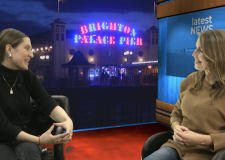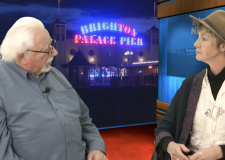News: The value of the Festival

The Brighton Festival attracts thousands of people to hundreds of shows. Its financial performance is worth looking at too. Frank le Duc reports
The Brighton Festival starts with the Children’s Parade on Saturday 4 May – the traditional opening to England’s biggest arts festival. It runs in parallel with the Brighton Fringe and Artists Open Houses. And not forgetting the Great Escape – a weekend of pop doubling as a music industry conference – in the middle of it all.
Brighton benefits in many ways from the three-week festival, the associated cultural activity and the buzz created by it all. It attracts more than 150,000 people to shows, performances and events and contributes an estimated £20 million to the local economy. The figure is based on old research and is believed by some to be an underestimate. The festival is supported by Brighton and Hove City Council and the Arts Council. Some describe their input as a subsidy, others as an investment.
Less than a week ago the whole question of arts funding was put under the microscope by cabinet minister Maria Miller. The Culture Secretary, a former oil company marketing manager and advertising executive, said: “A proper grasp of the potential economic impact of culture would serve us all well.”

She reached out to those working in the arts at the same time as she sketched a picture of the pressures on public funding. She praised the contribution of arts and culture to trade and the economy. And she outlined the ways in which she saw the landscape changing as the government struggles to improve the performance of the economy.
Some of that public money is funnelled through the Arts Council – about £350 million a year. The South East office of the Arts Council England is based in the “cultural quarter” in Brighton. It supports a variety of organisations, including
the Brighton Festival. The debate over what should be funded, and with how much, is unlikely ever to be settled.
Brighton Festival chief executive Andrew Comben told a recent Chamber of Commerce gathering: “We know 150,000 to 200,000 people will come every year.” He said that since 1967 the festival had built a brand with loyalty, sophistication and innovation. This year’s festival alone would include more than 370 performances and 154 events in 30 venues across Brighton and Hove.
Paula Murray, a senior council official with close links to the world of arts and culture in Brighton, told the same gathering that the sector provided one in ten jobs locally. The festival and other arts and cultural offerings attract tourists, with about 60 separate festivals taking place throughout the year. And those attending spend money not just on shows, exhibitions and other events but on food and drink and somewhere to stay. And the regeneration of places such as New Road and Jubilee Square have been led by cultural projects.
Brighton Fringe managing director Julian Caddy said that the Fringe did not receive Arts Council funding. “It’s sad for some but it creates a certain resilience.” He said that there was a perception among some in the arts world that only those that received public funding were worthy, adding: “It’s sometimes surprising how little some people know of the Fringe because it doesn’t receive funding.”
Mr Caddy said that the Fringe flipped the process on its head, democratising the whole process. Paying audiences determined whether a show survived rather than members of the arts establishment deciding whether something was likely to be good-quality art. He said: “It’s an environment which is bloody hard. People fail regularly in a fringe environment. If a show isn’t good enough it won’t survive.
“It’s about being able to support work which will be enriching to our lives”
“There’s a place for subsidy in that process. Inevitably many more people are going to find a stand-up comic entertaining than an important piece of work from a ballet company. And stand-up is the cheapest art form to produce. It’s about being able to support work which will be enriching to our lives.”
About a quarter of the events in this year’s Fringe are home grown or home based, he said. That’s between 150 and 200. He contrasted the picture with the Edinburgh Fringe “which is very largely imported”. And while money and success may motivate some, others put on their shows for pleasure more than profit.
The question of how much should be publicly funded attracts many answers – including from those who would pit money for the arts against spending on schools, policing and health. Ask the audience? Brighton benefits hugely from its success in ticket sales and merchandising.
The stage may be set for a more straitened landscape but festival fever means the picture is far from bleak.
THE POLITICAL LANDSCAPE
The Arts Council has just announced a reorganisation. Budget pressures are squeezing public funding for artists and performers. A recession may not seem like the best time to hope for corporate or personal philanthropy. And audiences are feeling the pinch too.

Against this backdrop, and ten days before the start of the Brighton Festival, the Culture Secretary Maria Miller spoke about public funding for the arts. Her speech, to some of the leading players in the arts world, recognised the differences between artistic merit and commercial success. But others were quick to point out how hard it was to predict whether, say, a film or play would attract enough people to see it to make a profit.
Mrs Miller said: “Culture does not simply have a role to play in bringing about a return to growth. Rather, it should be central to these efforts. That is not to say that every sinew of effort and artistic endeavour needs to be strained to bring in turnover and profit – that is neither appealing nor sensible to approach it in that way.
“It is essential that government investment in culture continues despite these testing economic times. Public funding for the arts provides support, offers certainty and unlocks further potential. And that is why we continue to dedicate hundreds of millions of pounds of taxpayers’ money to this sector.
“The government is committed to a mixed economy model where targeted public funding will stimulate money from other sources, whether that is philanthropy or commercially generated. I know there are reservations about this focus on philanthropy across the sector so let me reassure you here and now that no one considers philanthropy a panacea, a silver bullet or a magic wand. It is not seen as a substitute for government support, but it is complementary.”
She cited Matthew Taylor, a former adviser to Tony Blair. He said that cultural organisations might be hubs of creative flair at their heart but they were also businesses and had to combine creativity with commercial nous. The two were not mutually exclusive, he said. Entrepreneurial endeavour did not come at the price of cultural excellence.
In her speech to leading figures in the arts world, Mrs Miller said: “Faced with a crippling budget deficit, there are big choices to be made at both a national and a local level, few of which are easy or palatable. Some in the sector say that arts funding should be treated as a special case [but] culture cannot be seen in isolation at a time of unprecedented economic challenge.
“It is with this at the fore of my mind that I come to you today and ask you to help me reframe the argument: to hammer home the value of culture to our economy. Some simply want money and silence from government but in an age of austerity when times are tough and money is tight our focus must be on culture’s economic impact.
“To maintain the argument for continued public funding, we must make the case as a two-way street. We must demonstrate the healthy dividends that our investment continues to pay. We should value the arts for their own sake. We should, and as a country we do, but now in these tough economic times we need to make a broader case.”
Brighton Kemptown MP Simon Kirby, a fellow Conservative, is a parliamentary private secretary to a minister in Mrs Miller’s department. Were he to bring her to Brighton during the festival, he would be able to show her how Brighton is leading the way.




















